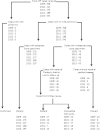Evaluation of AFP surveillance indicators in polio-free Ghana, 2009-2013
- PMID: 24996415
- PMCID: PMC4094438
- DOI: 10.1186/1471-2458-14-687
Evaluation of AFP surveillance indicators in polio-free Ghana, 2009-2013
Abstract
Background: Ghana recorded the last case of indigenous wild poliovirus in 1999 but suffered two more outbreaks in 2003 and 2008. Following the World Health Organization (WHO) guidelines, transmission was interrupted through high routine immunisation coverage with live-attenuated oral polio vaccine (OPV), effective acute flaccid paralysis (AFP) surveillance and supplementary immunisation activities (SIA). This article describes the results of a five-year surveillance of AFP in polio-free Ghana, evaluate the surveillance indicators and identify areas that need improvement.
Methods: We investigated 1345 cases of AFP from children aged less than 15 years reported to the Disease Surveillance Department from January 2009 to December 2013. Data on demographic characteristics, vaccination history, clinical presentation and virological investigation on stool specimens collected during investigation were analysed.
Results: Of the specimens analysed, 56% were from males and 76.3% were from children less than 5 years of age. Twenty-four percent of the children received up to 3 doses of OPV, 57% received at least 4 doses while the status of 19% was unknown. Core AFP surveillance indicators were partly met for non-polio AFP rate while the WHO target for stool adequacy and timeliness was exceeded over the period of study. All the cases were classified virologically, however no wild polio was found. Sixty-day follow-up was conducted for 56.3% of cases and 8.6% cases classified as compactible with polio.
Conclusion: Both laboratory and epidemiological surveillance for AFP were efficient and many WHO targets were met. However, due to the risk of poliovirus importation prior to global eradication, longterm surveillance is required to provide a high degree of confidence in prevention of poliovirus infection in Ghana. Thus, efforts should be made to strengthen regional performance and to follow-up on all AFP cases in order to establish proper diagnoses for the causes of the AFP leading to proper care.
Figures



References
-
- WHO. Recommended standards for surveillance of selected vaccine preventable diseases: vaccines and biologicals. Geneva: World Health Organization; 2003. pp. 31–34. Google Scholar.
-
- Mandell GL, Bennett JE, Dolin R, editor. Principles and practice of infectious diseases. 5. New York: Churchill Livingston; 2000.
-
- Heymann DL. Control of communicable diseases manual. 18. Washington, DC: American Public Health Association; 2004.
-
- Shibuya K, Murray CJL. In: The global epidemiology of infectious diseases Volume 4. Murray CL, Lopez AD, Mathers CD, editor. Geneva: World Health Organisation; 2004. Poliomyelitis; pp. 111–149.
Publication types
MeSH terms
Substances
Grants and funding
LinkOut - more resources
Full Text Sources
Other Literature Sources
Miscellaneous

